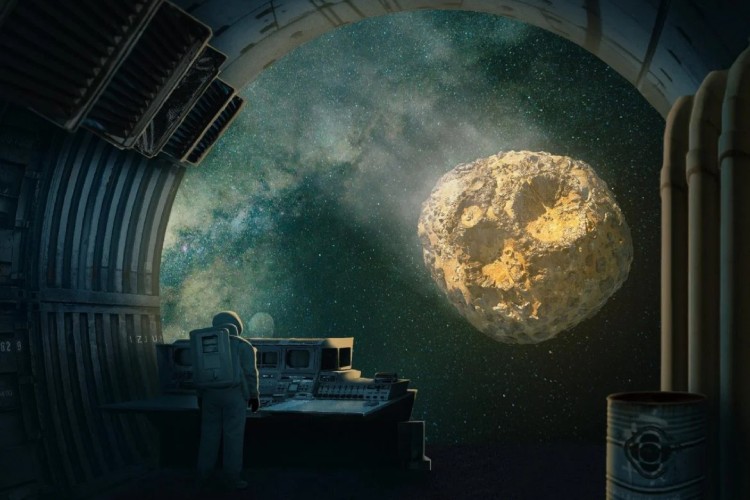More photos
In less than 9 months, NASA will send a spacecraft to an asteroid that is packed with enough metal to make every American family richer than Jeff Bezos…
NASA is preparing to send a spacecraft to a 200-kilometer-wide asteroid named 16 Psyche that is estimated to be worth 70,000 times the global economy. If all goes according to plan, the probe will blast off into space on its long journey sometime in October 2023 and should reach the ultra-precious asteroid by August 2029. The Psyche mission was originally planned for launch in late 2022, however, the program ran into "development issues" that caused a one-year delay. Things are finally back on track and the spaceship is almost ready to travel through the solar system. We reveal everything you need to know about 16 Psyche and the NASA research mission that could prove to be epochal.
What makes 16 Psyche so special?
16 Psyche is a giant M-type asteroid discovered by Italian astronomer Annibale de Gasparis in 1852, making it the 16th asteroid ever discovered. It is named after the Greek goddess of the soul and is about the size of Massachusetts, with an average diameter of 200 km. The asteroid lies in the belt between Mars and Jupiter and is believed to be part of the core of a shattered early planet, making it truly special.
Unlike most other asteroids that are usually composed of rock or ice, scientists, thanks to various studies, believe that Psyche is almost entirely made of iron and nickel. In fact, NASA scientist Lindy Elkins-Tanton calculated back in 2017 that the iron content of a metal-rich asteroid could be worth $10,000 quadrillion (that's $10,000 followed by 15 more zeros). According to the World Bank, the entire global economy is currently worth approximately $110 trillion; but more on that later.
Why is NASA sending a spacecraft towards 16 Psyche?
When we talk about this giant asteroid, it hides much more than just mineral and metal wealth. In fact, a space rock orbiting the Sun could hold the answers to many mysteries of our solar system and its formation, including our planet. Scientists believe that Psyche may have started as a planet that failed to form and its outer layers of rock were blown away by violent collisions during the early formation of our solar system, leaving behind a core similar to that of Earth and other planets.
That's why NASA decided in 2017 to send a spacecraft to study the asteroid up close, which could reveal secrets about Earth's own core. NASA claims this will be humanity's first visit to a celestial object made mostly of metal.
What are the cutting-edge technologies that will be used by the Psyche spacecraft?
The probe, which is slightly larger than a typical hatchback, will be equipped with special gear to study the asteroid and identify its material content. According to NASA, the spacecraft will be equipped with multiple cameras that will record Psyche, along with a gamma-ray neutron spectrometer to measure elemental composition.
They will also use a magnetometer to detect the magnetic field, which will confirm if it is indeed the core of a failed planet. The probe will use an onboard radio to map the asteroid's gravity and internal structure.
How long will it take to reach the asteroid and how much will the mission cost?
A few months ago, NASA announced a revised mission launch schedule. The spacecraft is expected to launch on a SpaceX Falcon Heavy rocket in October 2023 and embark on a 450 million kilometre journey to reach the asteroid. With the new timeline in place, the probe will arrive in Mars orbit sometime in 2026 and head for the asteroid with the help of gravity. If all goes according to plan, the spacecraft will successfully arrive at 16 Psyche in 2029.
The spacecraft is equipped with large solar panels that are the size of a tennis court once deployed and will generate electricity to power the propulsion unit. Unlike traditional rocket propulsion, this innovative technology uses electricity to convert xenon gas into xenon ions that provide thrust.
According to NASA, the total cost of the mission, including the launch, is $985 million, of which $717 million has already been spent by June 2022.
Will this mission open the door to space mining?
As mentioned earlier, 16 Psyche is believed to be made entirely of various metals, consisting mainly of iron, nickel and possibly a number of other rare metals such as gold, platinum, copper, cobalt, iridium and rhenium. The estimated value of $10,000 quadrillion is obviously very tempting because it amounts to about $30 billion for every single American citizen. However, it won't be as easy as putting a lasso around the asteroid and dragging it back to our planet. Space mining is an unimaginably difficult task and is currently under investigation. However, NASA's Psyche mission does not apply to mining or returning minerals from an asteroid, but studying it, which could actually open the door to space mining in the future.





















